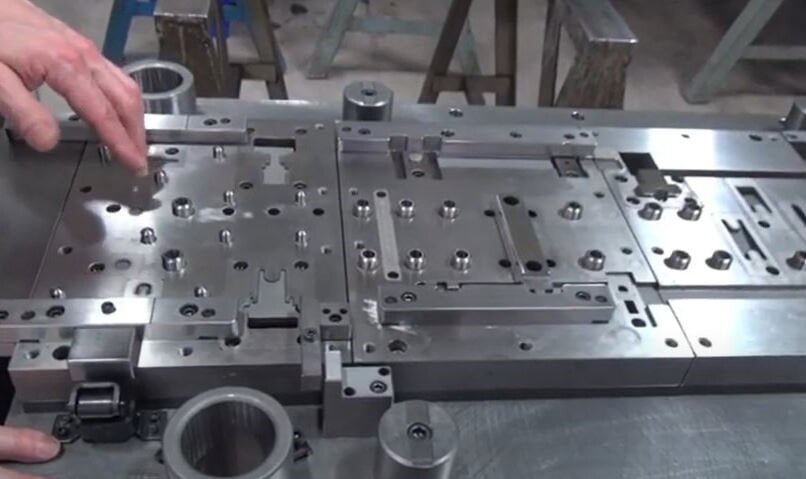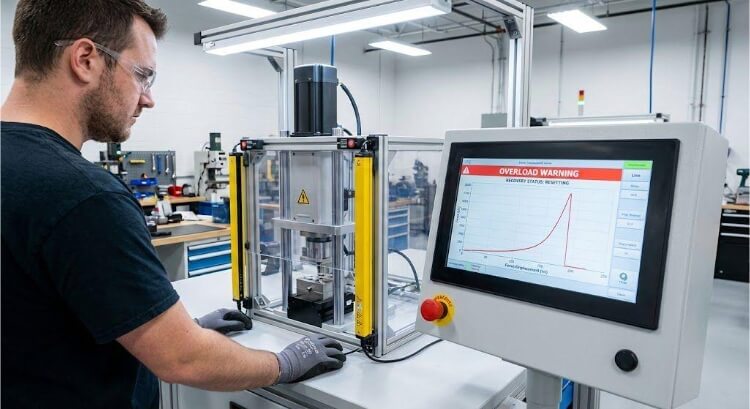When designing products, manufacturers often face the challenge of producing complex metal parts in large quantities without losing precision or slowing down production. Progressive die stamping helps solve this problem. It offers a cost-effective method to produce high-quality metal parts quickly and efficiently.
Progressive die stamping can improve your production time and product quality. Read on to discover how this process works and how it might fit into your next project.
What Is Progressive Die Stamping?
Progressive die stamping is a multi-step process that uses a single die set to perform various operations on a metal strip. Each operation happens in stages, with the material progressing through the die. This allows manufacturers to create complex parts efficiently and at a high production rate.
The process begins with a metal strip being fed into the press. The die performs a series of actions, such as punching, cutting, or bending. As the strip moves through the die, it undergoes these operations in sequence. When the strip exits the die, it is transformed into the desired part.
Materials Commonly Used in Progressive Die Stamping
Various materials can be used in progressive die stamping, each chosen based on the part’s requirements. Common materials include:
- Steel: Steel is commonly used in automotive and heavy machinery parts for its strength and durability.
- Aluminum: Known for its lightweight and corrosion-resistant properties, aluminum is ideal for aerospace and electronics applications.
- Stainless Steel: Offers high corrosion resistance and strength, making it perfect for industries like medical devices and food processing.
- Brass and Copper: These materials are used for their excellent conductivity, making them popular in electronics and electrical components.
What Makes Up a Progressive Die?
A progressive die is like an assembly line inside a press. Each part has a specific job: shaping metal precisely. Let’s look at the key pieces.
Die Stations
Think of stations as workstations in a factory. The metal strip moves through each one, getting a new feature at every stop. Early stations might pierce holes, while later ones bend or cut the final shape.
Punches and Dies
- Punches are the moving parts that push into the metal.
- Dies are the fixed parts that shape the metal from below.
- Together, they cut, bend, or form the material with each press stroke.
Stripper Plates
After a punch pierces the metal, the stripper plate pulls it back out. This keeps the strip flat and prevents it from sticking to the punch.
Pilots
These small pins align the metal strip between stations. They ensure every operation lines up perfectly for consistent parts.
Feed Mechanism
This system pushes the metal strip forward in precise steps. For tighter control, it can be mechanical (gears) or servo-driven.
Guide Pins and Bushings
- Guide pins keep the upper and lower die sections aligned.
- Bushings reduce friction as the pins move.
- They prevent misalignment that could ruin parts.
Cam Units
Cams create sideways or angled movements for complex shapes. They let the die form features that straight punches can’t reach.

How Does Progressive Die Stamping Work?
Progressive die stamping transforms metal into finished parts through precise steps. Here’s how the process flows from start to finish.
Blank Feeding
The process begins with blank feeding, where a continuous strip of metal (often a coil) is unwound and fed into the die. A feed mechanism typically pulls the material, ensuring the strip moves steadily through the die.
Stamping Operation
Once the metal strip is in place, the stamping operation begins. This is the primary phase, during which the metal undergoes various processes such as punching, bending, or forming. Each station performs a specific task as the strip moves through the die.
Cutting
Cutting is another key operation in progressive die stamping. Cutting tools or punches trim excess material from the strip at specific points in the die, leaving behind the desired part shape.
Collection and Ejection
Once the part has been fully stamped, collection and ejection take place. The finished parts are separated from the remaining strip and ejected from the die.
Types of Progressive Dies
There are different types of progressive dies, each designed for specific tasks. Let’s examine the various types of progressive dies and their differences.
Single Station Dies
Single-station dies are the simplest type. As the name suggests, these dies have only one operation station. This station performs one task, such as punching, cutting, or forming. They are best for simpler parts or when only one operation is needed.
Multi-Station Dies
Multi-station dies can perform multiple operations in a single stroke. Each station carries out a different task. As the metal strip moves through the die, it goes through each station. These dies are perfect for high-volume production, requiring several steps to complete the part.
Compound Dies
Compound dies combine multiple operations into one station. For example, a compound die could punch a hole and cut the outer shape of the part in one press stroke. Reducing the number of stations needed helps improve efficiency and speed.
Combination Dies
Combination dies to mix features of both compound and multi-station dies. They combine different processes in one die, which may be spread across various stations. For example, one station might punch a hole while another forms a bend.
Key Benefits of Progressive Die Stamping
Progressive die stamping offers several advantages, making it an excellent choice for producing high-quality metal parts at large scales. Here are the key benefits highlighting how efficient and effective this process can be.
High-Speed Production
One of the most significant benefits of progressive die stamping is its ability to produce parts quickly. The process runs continuously, allowing multiple operations to happen in one cycle, reducing the time needed to make each part.
Cost Efficiency
Progressive die stamping is cost-effective, especially for large production runs. Since the process uses a continuous feed of metal, there is less need for frequent tool changes. This reduces downtime and labor costs, saving money over time.
Precision and Consistency in Production
Each part is made with a high level of detail and accuracy, ensuring that all components meet the necessary specifications. The precise tooling and automated process ensure that parts are consistently shaped and sized.
Versatility in Part Design
Progressive die stamping is versatile when it comes to part design. It can handle various shapes and sizes, from simple flat parts to complex multi-dimensional components. This flexibility allows manufacturers to produce detailed designs with high precision and minimal setup time.
Comparison of Progressive Die Stamping and Other Stamping Methods
When choosing a stamping method, it’s essential to understand the differences between the various techniques available. Each method has its strengths and is suited for specific applications. Let’s compare progressive die stamping with other commonly used stamping methods.
| Stamping Method | Operation Type | Efficiency | Suitability | Cost |
|---|---|---|---|---|
| Progressive Die Stamping | Multiple operations in sequence in one die | High-speed, continuous process, ideal for high-volume production | Best for high-volume, complex parts with multiple features | Cost-effective for high-volume production |
| Single-Stage Stamping | One operation per press cycle | Slower, less efficient for high-volume production | Best for simple, less complex parts | Less cost-effective for large production runs |
| Transfer Die Stamping | Individual blanks are transferred between stations for each operation | Slower, with additional handling and tool changes | Best for complex shapes with intricate details | Higher cost due to additional handling and complexity |
| Four-Slide Stamping | Multiple synchronized slides perform operations simultaneously | Versatile, but slower than progressive die stamping | Best for parts with complex bends or multi-axis movements | Higher cost due to slower production and complexity |
Uses of Progressive Die Stamping
Progressive die stamping is a widely used manufacturing process that plays a key role in several industries. Below are some of the primary sectors that benefit from this process.
Automotive Industry
Progressive die stamping is used to make a wide range of parts in the automotive industry. These include brackets, panels, chassis components, connectors, and small metal fasteners. The automotive sector’s ability to produce complex and precise parts in large quantities is critical.
Consumer Electronics
Progressive die stamping is also essential in the consumer electronics industry, where precision and consistency are key. It makes parts like connectors, terminals, housings, and enclosures for products like smartphones, computers, and home appliances.
Aerospace Manufacturing
Aerospace manufacturing requires parts that are lightweight but also strong and durable. Progressive die stamping meets these needs by efficiently producing aircraft and spacecraft components like brackets, structural supports, and fasteners.
Conclusion
Progressive die stamping is a robust manufacturing process that helps companies produce high-quality metal parts efficiently and at scale. By understanding how this process works, manufacturers can streamline their production processes, reduce costs, and improve product consistency.
If you’re looking for efficient, high-quality manufacturing solutions for your next project, we’re here to help! Contact us today for a personalized consultation, and let’s discuss how we can streamline your production process and meet your specific needs.
Hey, I'm Kevin Lee

For the past 10 years, I’ve been immersed in various forms of sheet metal fabrication, sharing cool insights here from my experiences across diverse workshops.
Get in touch

Kevin Lee
I have over ten years of professional experience in sheet metal fabrication, specializing in laser cutting, bending, welding, and surface treatment techniques. As the Technical Director at Shengen, I am committed to solving complex manufacturing challenges and driving innovation and quality in each project.




